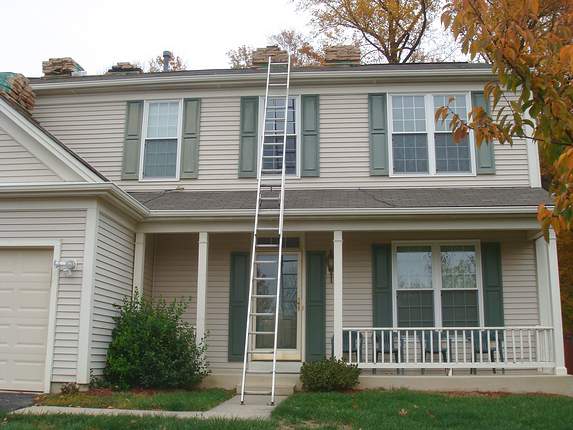  New Roof Upper Marlboro, Maryland: This home was ready for a new
roof; and since the existing roof shingles were very flat (as opposed to curling), one of the
options available was a roof over. Only about 10% of the roofs that I inspect actually
qualify for a "roof over". New Roof Upper Marlboro, Maryland: This home was ready for a new
roof; and since the existing roof shingles were very flat (as opposed to curling), one of the
options available was a roof over. Only about 10% of the roofs that I inspect actually
qualify for a "roof over". |
|
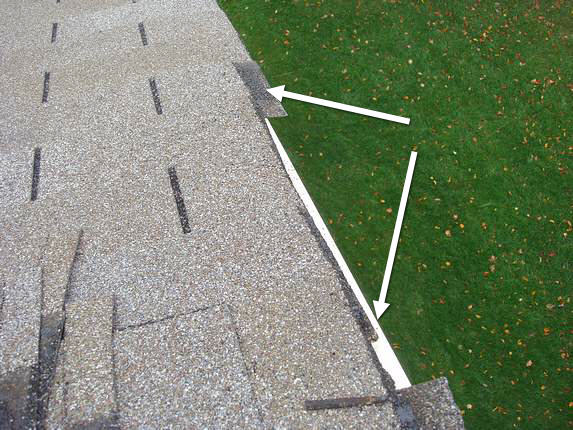  Shingle Rake
Edges: When doing a "roof over" we always cut back the existing
shingles so that only the newly applied shingles can be seen from the ground. Shingle Rake
Edges: When doing a "roof over" we always cut back the existing
shingles so that only the newly applied shingles can be seen from the ground.
|
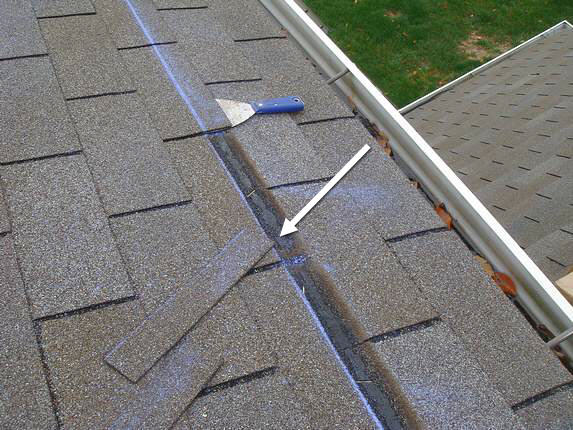  Cutting the third
Course of Shingles: This is a "super secret" technique that I use to flatten out the first couple
of new courses of shingles when installing a re-roof. Well, maybe it's not such a secret
anymore; but that's OK. Cutting the third
Course of Shingles: This is a "super secret" technique that I use to flatten out the first couple
of new courses of shingles when installing a re-roof. Well, maybe it's not such a secret
anymore; but that's OK. |
|
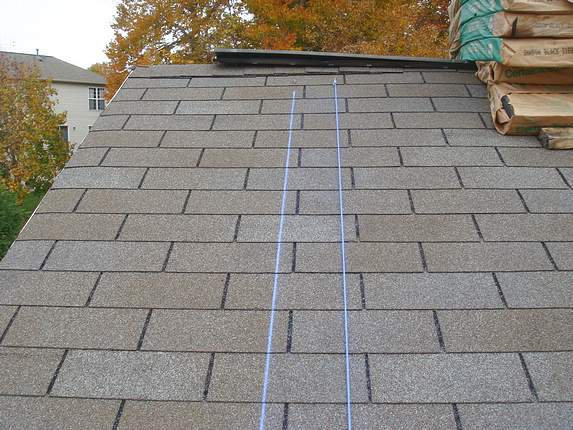  Chalk
lines: I always use chalk lines to keep the new shingles in perfect
alignment. Also notice that the joints are "staggered" to keep the new roof really
flat. Chalk
lines: I always use chalk lines to keep the new shingles in perfect
alignment. Also notice that the joints are "staggered" to keep the new roof really
flat.
|
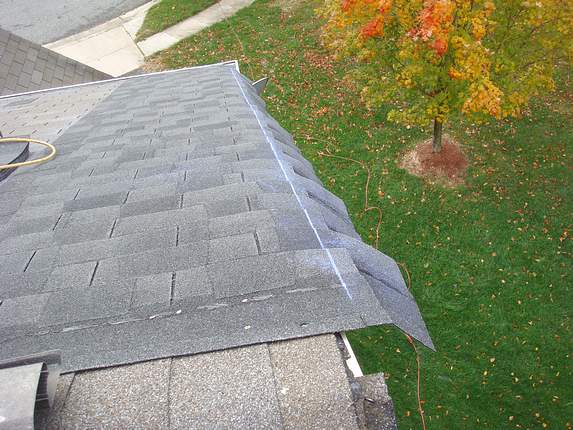  One of the cool things about this
method is that I can chalk a line for the rake edge and cut the shingles perfectly straight.
It looks great! One of the cool things about this
method is that I can chalk a line for the rake edge and cut the shingles perfectly straight.
It looks great! |
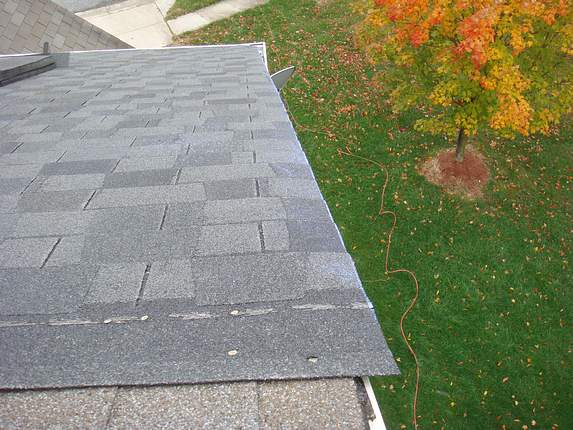  Cutting the Rake
Edges with a Hook Blade: After the edge has been chalked to overhang about one inch, we cut along
the line, using it as a guide. Now that's a really straight edge! Cutting the Rake
Edges with a Hook Blade: After the edge has been chalked to overhang about one inch, we cut along
the line, using it as a guide. Now that's a really straight edge! |
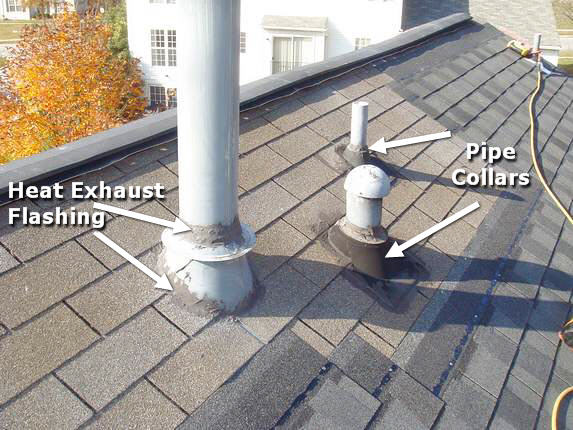  Too much Tar and
Goop! Notice all that tar that some other roofer
used to prevent leaks? Here's the correct formula: More tar smeared around = More
Leaks! Too much Tar and
Goop! Notice all that tar that some other roofer
used to prevent leaks? Here's the correct formula: More tar smeared around = More
Leaks!
I see this major roofing mistake made all the time, and I am amazed at the lack
of knowledge of my predecessors! |
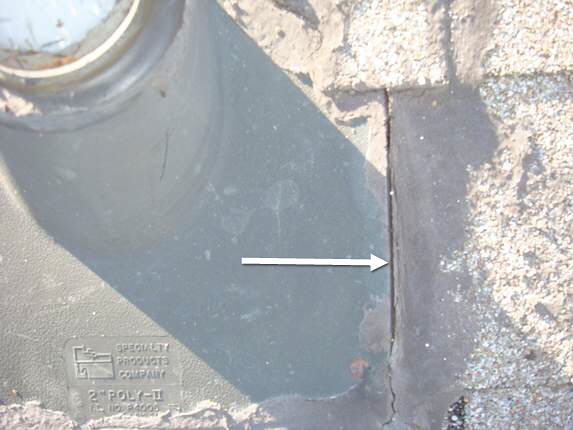  Big Roof Leak: This
tiny little crack was responsible for the drywall damage in the upstairs bedroom -- it's what
happens when an inexperienced "roofer" smears roofing tar all over a plastic or rubber pipe
collar. The petroleum distillates in the tar cause the plastic to distort; and, well you can
see what happened. Big Roof Leak: This
tiny little crack was responsible for the drywall damage in the upstairs bedroom -- it's what
happens when an inexperienced "roofer" smears roofing tar all over a plastic or rubber pipe
collar. The petroleum distillates in the tar cause the plastic to distort; and, well you can
see what happened. |
|
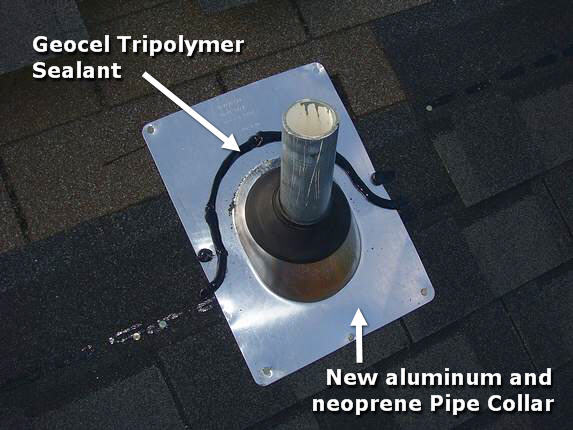  Geocel Tripolymer
Sealant: If it weren't for wind driven rain this sealant would not be
necessary; but in this area, it's a MUST. By the way, Geocel Tripolymer is the best
sealant on the market -- it's compatible with rubber and asphalt, and pretty much seals for a
lifetime . . . it's the only sealer we use. Geocel Tripolymer
Sealant: If it weren't for wind driven rain this sealant would not be
necessary; but in this area, it's a MUST. By the way, Geocel Tripolymer is the best
sealant on the market -- it's compatible with rubber and asphalt, and pretty much seals for a
lifetime . . . it's the only sealer we use.
|
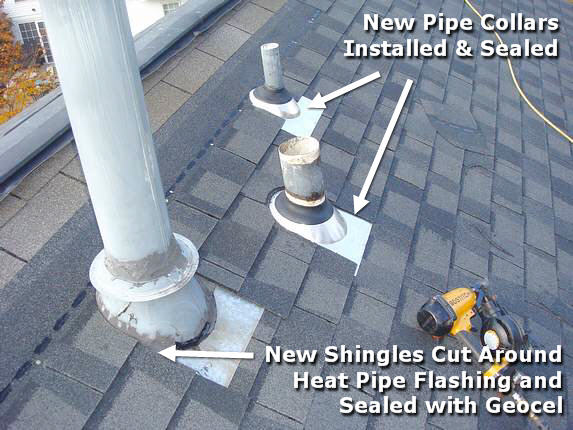 |
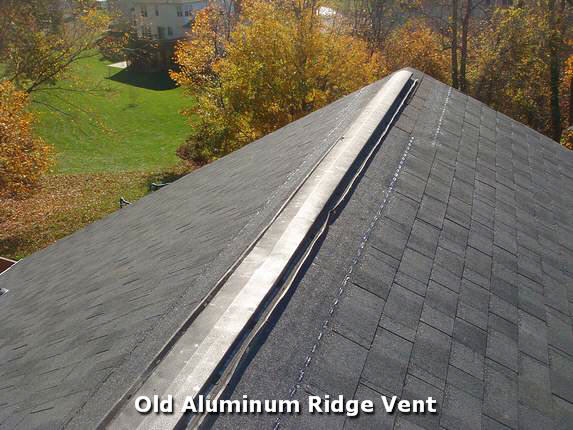 |
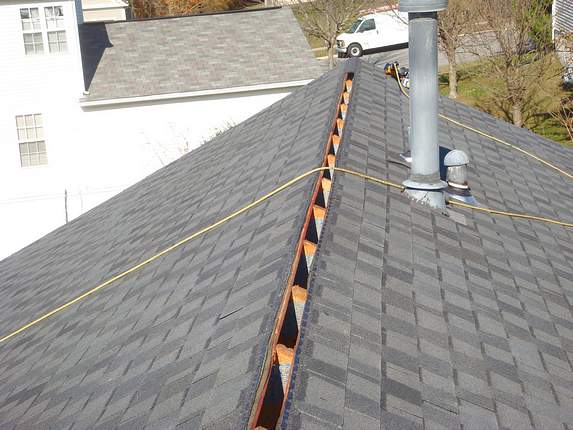 |
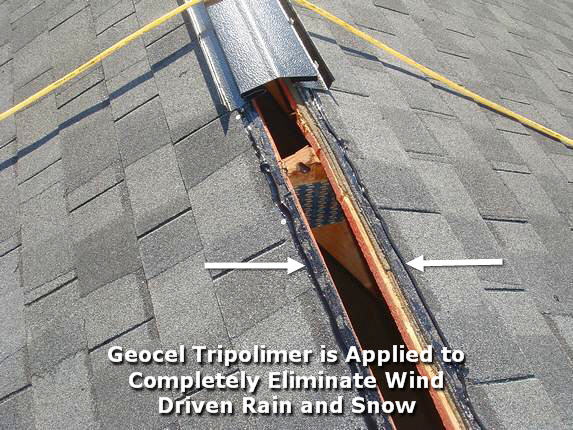  Sealing Down the
Metal Ridge Vent is a step almost all roofers just skip. It's necessary, but I'd say that
99% of the old vents I remove have no sealant! No, actually I think it's 99.9%! The
sealant helps preserve the underlayment and adds to the efficiency of the ridge vent
system. Sealing Down the
Metal Ridge Vent is a step almost all roofers just skip. It's necessary, but I'd say that
99% of the old vents I remove have no sealant! No, actually I think it's 99.9%! The
sealant helps preserve the underlayment and adds to the efficiency of the ridge vent
system. |
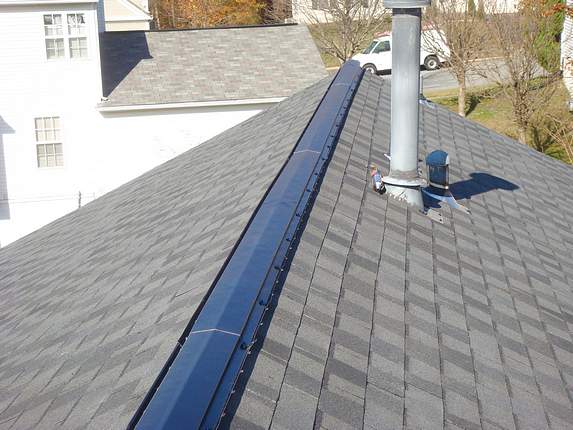 |
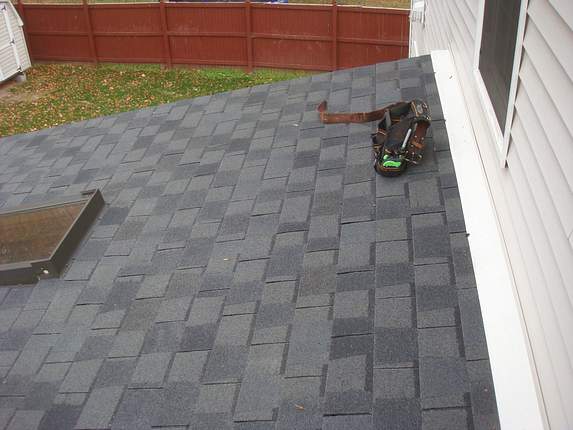 |
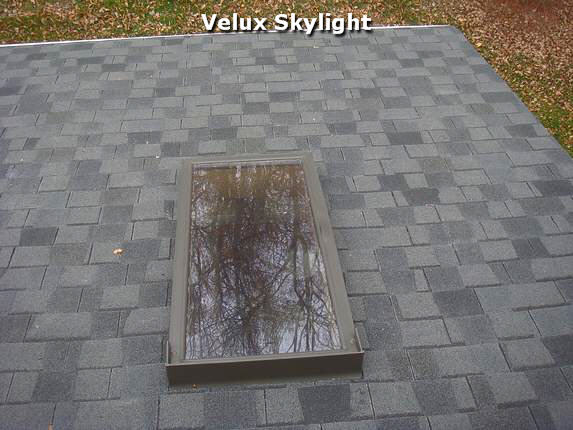 |
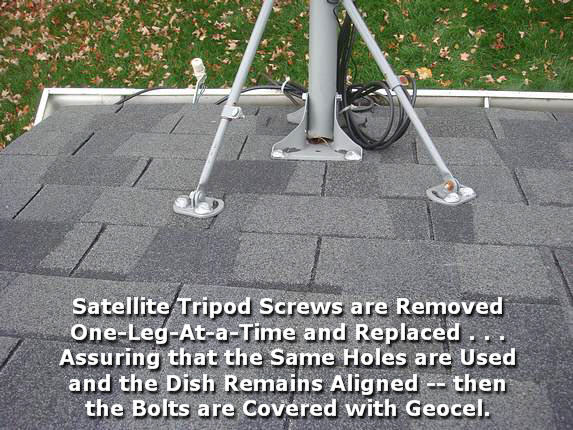  Satellite Dishes
mounted on the Roof can be kind of tricky, but we actually remove each let of the tripod --
one-at-a-time -- so that we can relocate the unit properly, in the same holes under the new
roofing. Then we seal the bolts with Geocel for a perfectly waterproof system. Satellite Dishes
mounted on the Roof can be kind of tricky, but we actually remove each let of the tripod --
one-at-a-time -- so that we can relocate the unit properly, in the same holes under the new
roofing. Then we seal the bolts with Geocel for a perfectly waterproof system. |
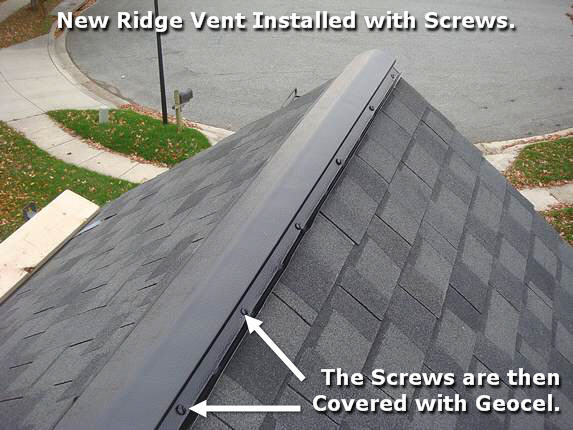  Geocel Sealant again;
this time for covering the screw heads on the satellite tripod. Geocel Sealant again;
this time for covering the screw heads on the satellite tripod. |
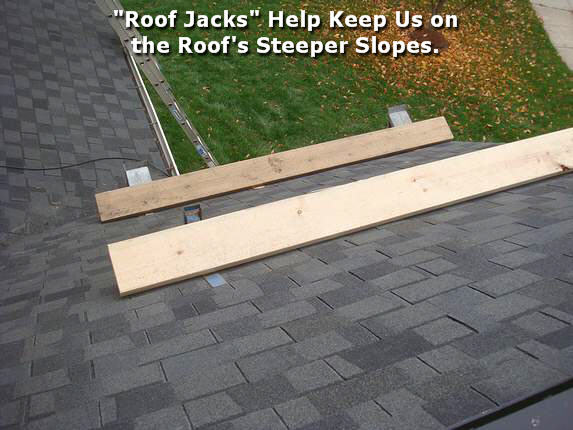  Roof Jacks are a good way to keep us
on the roof without damaging the new shingles; they fasten under the new shingle tabs so the
screws / nails don't penetrate the surface . . . Roof Jacks are a good way to keep us
on the roof without damaging the new shingles; they fasten under the new shingle tabs so the
screws / nails don't penetrate the surface . . . |
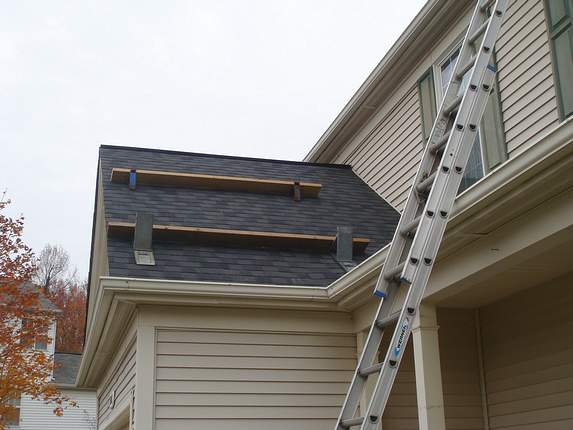 |
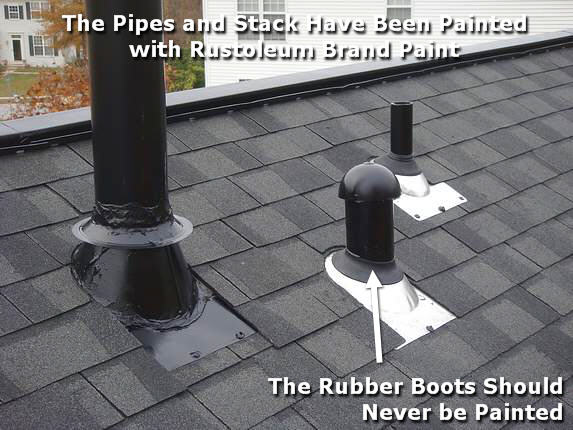  Rust Inhibiting Paint
on the Roof Pipes: On this project in Upper Marlboro, Maryland, we painted the pipes with
Rustoleum Brand Paint -- it's a great preservative and lasts forever. Notice that the rubber
boots weren't painted -- for the same reason you don't put tar on rubber and plastic. Rust Inhibiting Paint
on the Roof Pipes: On this project in Upper Marlboro, Maryland, we painted the pipes with
Rustoleum Brand Paint -- it's a great preservative and lasts forever. Notice that the rubber
boots weren't painted -- for the same reason you don't put tar on rubber and plastic. |
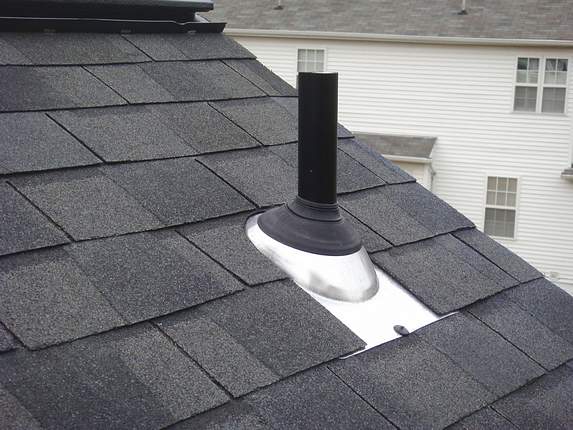 |
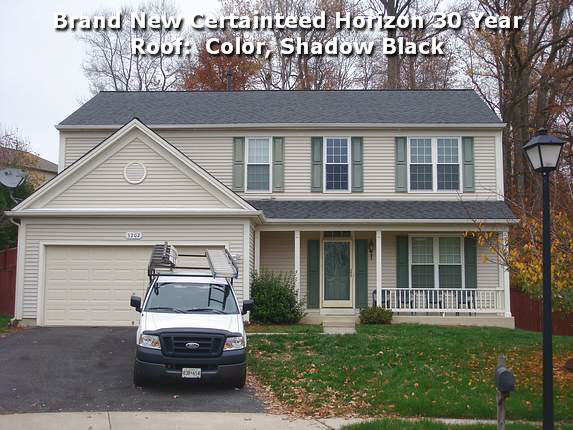  The new Certainteed
Horizon Roofing Shingles carry a manufacturer's warranty of 30 years, and Home
Restorations warrants the labor against leaks for ten (10) full years. The new Certainteed
Horizon Roofing Shingles carry a manufacturer's warranty of 30 years, and Home
Restorations warrants the labor against leaks for ten (10) full years. |

 New Roof Upper Marlboro, Maryland: This home was ready for a new
roof; and since the existing roof shingles were very flat (as opposed to curling), one of the
options available was a roof over. Only about 10% of the roofs that I inspect actually
qualify for a "roof over".
New Roof Upper Marlboro, Maryland: This home was ready for a new
roof; and since the existing roof shingles were very flat (as opposed to curling), one of the
options available was a roof over. Only about 10% of the roofs that I inspect actually
qualify for a "roof over".
 Cutting the third
Course of Shingles: This is a "super secret" technique that I use to flatten out the first couple
of new courses of shingles when installing a re-roof. Well, maybe it's not such a secret
anymore; but that's OK.
Cutting the third
Course of Shingles: This is a "super secret" technique that I use to flatten out the first couple
of new courses of shingles when installing a re-roof. Well, maybe it's not such a secret
anymore; but that's OK.  One of the cool things about this
method is that I can chalk a line for the rake edge and cut the shingles perfectly straight.
It looks great!
One of the cool things about this
method is that I can chalk a line for the rake edge and cut the shingles perfectly straight.
It looks great! Cutting the Rake
Edges with a Hook Blade: After the edge has been chalked to overhang about one inch, we cut along
the line, using it as a guide. Now that's a really straight edge!
Cutting the Rake
Edges with a Hook Blade: After the edge has been chalked to overhang about one inch, we cut along
the line, using it as a guide. Now that's a really straight edge!
 Too much Tar and
Goop! Notice all that tar that some other roofer
used to prevent leaks? Here's the correct formula: More tar smeared around = More
Leaks!
Too much Tar and
Goop! Notice all that tar that some other roofer
used to prevent leaks? Here's the correct formula: More tar smeared around = More
Leaks!
 Big Roof Leak: This
tiny little crack was responsible for the drywall damage in the upstairs bedroom -- it's what
happens when an inexperienced "roofer" smears roofing tar all over a plastic or rubber pipe
collar. The petroleum distillates in the tar cause the plastic to distort; and, well you can
see what happened.
Big Roof Leak: This
tiny little crack was responsible for the drywall damage in the upstairs bedroom -- it's what
happens when an inexperienced "roofer" smears roofing tar all over a plastic or rubber pipe
collar. The petroleum distillates in the tar cause the plastic to distort; and, well you can
see what happened.


 Sealing Down the
Metal Ridge Vent is a step almost all roofers just skip. It's necessary, but I'd say that
99% of the old vents I remove have no sealant! No, actually I think it's 99.9%! The
sealant helps preserve the underlayment and adds to the efficiency of the ridge vent
system.
Sealing Down the
Metal Ridge Vent is a step almost all roofers just skip. It's necessary, but I'd say that
99% of the old vents I remove have no sealant! No, actually I think it's 99.9%! The
sealant helps preserve the underlayment and adds to the efficiency of the ridge vent
system.

 Satellite Dishes
mounted on the Roof can be kind of tricky, but we actually remove each let of the tripod --
one-at-a-time -- so that we can relocate the unit properly, in the same holes under the new
roofing. Then we seal the bolts with Geocel for a perfectly waterproof system.
Satellite Dishes
mounted on the Roof can be kind of tricky, but we actually remove each let of the tripod --
one-at-a-time -- so that we can relocate the unit properly, in the same holes under the new
roofing. Then we seal the bolts with Geocel for a perfectly waterproof system.
 Geocel Sealant again;
this time for covering the screw heads on the satellite tripod.
Geocel Sealant again;
this time for covering the screw heads on the satellite tripod.
 Roof Jacks are a good way to keep us
on the roof without damaging the new shingles; they fasten under the new shingle tabs so the
screws / nails don't penetrate the surface . . .
Roof Jacks are a good way to keep us
on the roof without damaging the new shingles; they fasten under the new shingle tabs so the
screws / nails don't penetrate the surface . . .
 Rust Inhibiting Paint
on the Roof Pipes: On this project in Upper Marlboro, Maryland, we painted the pipes with
Rustoleum Brand Paint -- it's a great preservative and lasts forever. Notice that the rubber
boots weren't painted -- for the same reason you don't put tar on rubber and plastic.
Rust Inhibiting Paint
on the Roof Pipes: On this project in Upper Marlboro, Maryland, we painted the pipes with
Rustoleum Brand Paint -- it's a great preservative and lasts forever. Notice that the rubber
boots weren't painted -- for the same reason you don't put tar on rubber and plastic.
 The new Certainteed
Horizon Roofing Shingles carry a manufacturer's warranty of 30 years, and Home
Restorations warrants the labor against leaks for ten (10) full years.
The new Certainteed
Horizon Roofing Shingles carry a manufacturer's warranty of 30 years, and Home
Restorations warrants the labor against leaks for ten (10) full years. 

